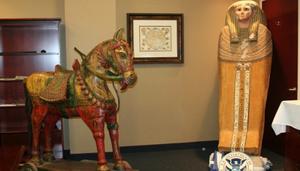MummiesDHS seizes ancient Egyptian relics in smuggling bust
Last Thursday DHS officials made an announcement that seemed more fitting for a Hollywood movie — agents had broken up an antiques smuggling ring that had illegally shipped ancient Egyptian artifacts to the United States; among the confiscated goods was a sarcophagus that dated back to the seventh century B.C.

Artifacts recovered by DHS operation // Source: ice.gov
Last Thursday DHS officials made an announcement that seemed more fitting for a Hollywood movie – agents had broken up an antiques smuggling ring that had illegally shipped ancient Egyptian artifacts to the United States. Among the confiscated goods was a sarcophagus that dated back to the seventh century B.C.
Immigration and Customs Enforcement agents inadvertently stumbled upon the smuggling ring while investigating an artifact that had been put up for sale online. Upon looking in to the case, investigators found that Joseph Lewis, a New York based collector of Egyptian antiquities, had allegedly conspired with three antique dealers to ship several items valued at an estimated $2.5 million including two sarcophagi, limestone figures, ancient coins, and Egyptian boats to the United States.
Egypt’s minister of antiquities, Zahi Hawaas, said, “This is one of the largest and most-significant cases of antiquities smuggling in recent memory.”
The antique dealers shipped the items from Dubai and snuck them past customs officials at JFK International Airport in New York and the Port of Newark, New Jersey using false descriptions and documentation. On the customs forms, the goods were described as “wood panels” and a “wooden painted box.”
To make shipping easier, the men reportedly cut the wooden sarcophagus into several pieces and hid other antiquities inside a container of furniture. The sarcophagus is believed to come from the twenty-sixth Dynasty of ancient Egypt, the last ruling dynasty before the Persian conquest in 550 B.C. It bears the name Shesepamutayesher and the title “Lady of the House,” which means that she was most likely the “wife of a middle-ranking official or priest,” said Aidan Dodson, a professor of archaeology at the University of Bristol in the United Kingdom who specializes in Egyptian royal lines.
Lawyers for the New York collector maintain his innocence.
“Joe Lewis is innocent and we look forward to his vindication in court,” said Peter Chavkin, one of Lewis’s lawyers.Lewis pleaded not guilty last Thursday and was released.
